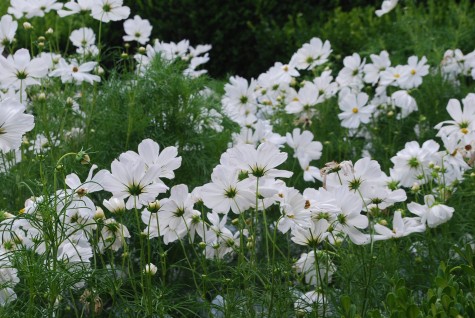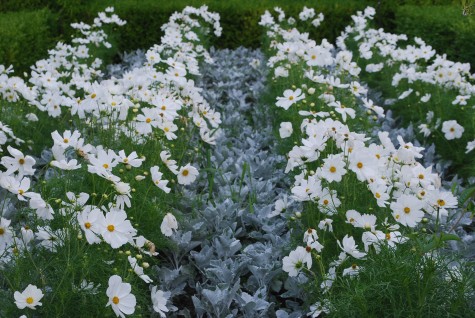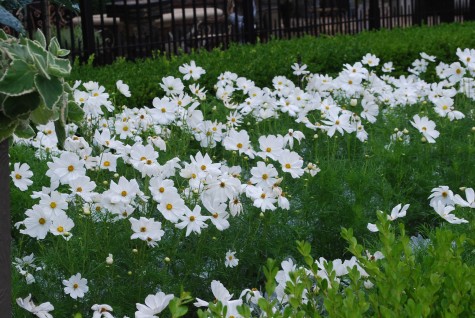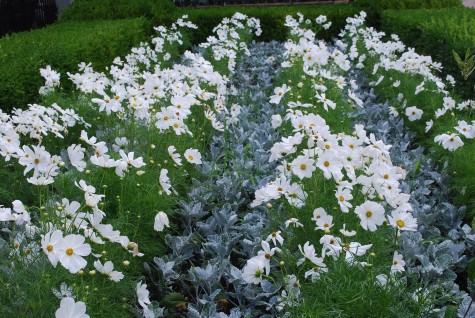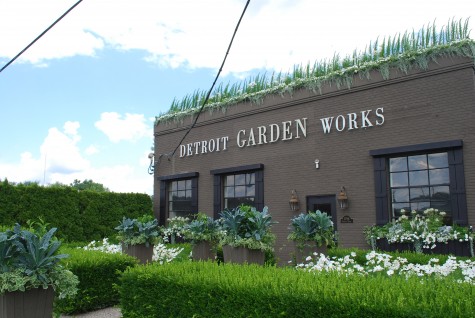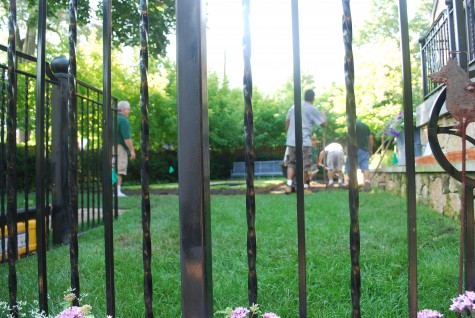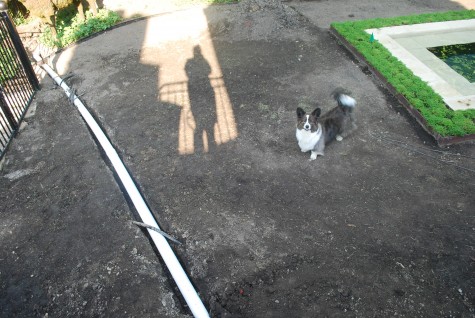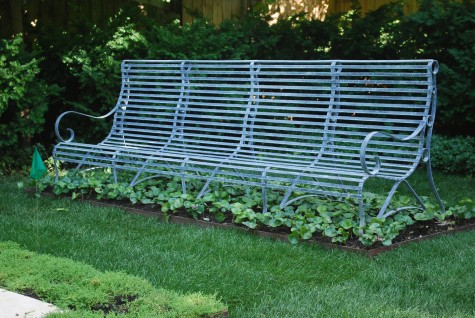Archives for July 2010
At A Glance: White Cosmos
Taking Charge Of The Clock

The new owners of the business that is right next door to my shop has not, to my knowledge, used their automatic irrigation system during the past two years. It shows. I installed the landscape for this storage company probably 14 years ago; the owners took great pride in the appearance of their business. As I cannot imagine that whomever owns this place now would want to pay what it would cost to replace the landscape, I choose to conclude that they have neglected to take charge of their clock. Their irrigation clock. I cannot imagine upon seeing these Annabelle hydrangeas, they would not run to the clock, and switch on the water.
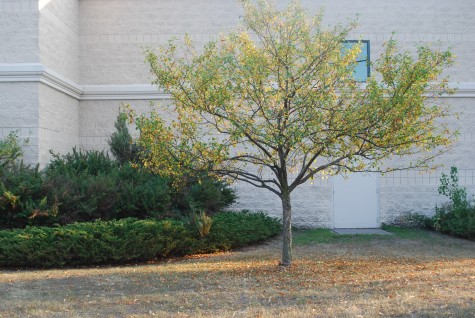
The landscape is in serious water distress. The crabapples are shedding leaves trying to stay alive by having fewer areas that are loosing water; I actually think the grass is dead. As I would rather write about a property owner who has a water problem they are trying to solve, I have a story. I do have a good client who lost three newly planted trees this spring; they drowned. It has been a process of trial and error to sort out the drainage issues from the irrigation problems. Upon engaging a new company to troubleshoot their irrigation system, numerous problems in the design and maintenance of the system became apparent. As an irrigation system is installed underground, you cannot spot the problems until they show up in the form of dying plants. Too much water can be as deadly as too little. Should you be so fortunate as to have in ground irrigation, you have a great tool within your grasp to provide water to you plants when they need it-without dragging the hose. The key-learning how to take charge and program your clock.
 My clients were fortunate to secure the services of a first rate irrigation company. When I say first rate, I mean there is a thoughtful and thorough person at the helm. He repaired all of the leaking pipes and heads. Then, he went to the clock. Most of what I will be covering regarding managing an irrigation system is paraphrased from what he took the time and trouble to explain to my clients. First and foremost-an irrigation system is not your big brother. It is a machine that needs to be programmed, depending on the season, the weather, and the types of plants you are watering.
My clients were fortunate to secure the services of a first rate irrigation company. When I say first rate, I mean there is a thoughtful and thorough person at the helm. He repaired all of the leaking pipes and heads. Then, he went to the clock. Most of what I will be covering regarding managing an irrigation system is paraphrased from what he took the time and trouble to explain to my clients. First and foremost-an irrigation system is not your big brother. It is a machine that needs to be programmed, depending on the season, the weather, and the types of plants you are watering.
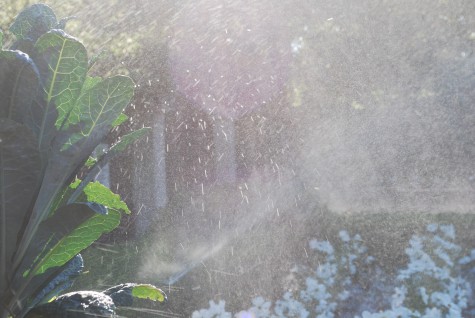 In the early spring, and in the later fall, when the temperatures are not above 60 degrees during the day, cut back on the water. When the weather is cool, the evaporation of water from the ground slows considerably; one a week watering is fine. Once the daytime temperatures go above 60, set your grass zones to run every other day for ten minutes. This is a benchmark that may work for you, or not-but it is a place to start. Grass in shadier spots where the evaporation rate is less, water less. Grass in full sun next to the asphalt pavement may need 12 minutes every other day. As grass can survive without water for 60 consecutive days, take the time to set the clock, and adjust the times if necessary. When it pours rain for two days, shut the machine off.
In the early spring, and in the later fall, when the temperatures are not above 60 degrees during the day, cut back on the water. When the weather is cool, the evaporation of water from the ground slows considerably; one a week watering is fine. Once the daytime temperatures go above 60, set your grass zones to run every other day for ten minutes. This is a benchmark that may work for you, or not-but it is a place to start. Grass in shadier spots where the evaporation rate is less, water less. Grass in full sun next to the asphalt pavement may need 12 minutes every other day. As grass can survive without water for 60 consecutive days, take the time to set the clock, and adjust the times if necessary. When it pours rain for two days, shut the machine off.
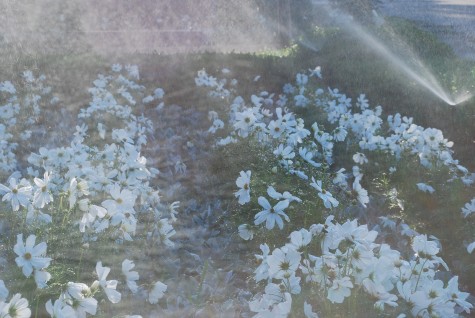 Shrub beds, trees, and established annuals need less water than grass. Check to be sure you lawn zone is not accidentally watering a shrub bed-that bed may be getting unneeded overlap from one zone to another that could damage those shrubs. Established trees and shrubs rarely need that much water, unless there is a drought-so resist the urge to water by rote. Always err on the dry side. If things look wilty, turn the time set to water on the clock up. If things look brown, turn the times way up. If things look saturated, or yellowish, turn the clock to the “Off” position. Automatic means just that-whether it is hot or cold, whether we have had 2 inches of rain yesterday, or no rain for a month, an irrigation machine will continue to water that the same time and rate as the last time you looked at your clock and set it.
Shrub beds, trees, and established annuals need less water than grass. Check to be sure you lawn zone is not accidentally watering a shrub bed-that bed may be getting unneeded overlap from one zone to another that could damage those shrubs. Established trees and shrubs rarely need that much water, unless there is a drought-so resist the urge to water by rote. Always err on the dry side. If things look wilty, turn the time set to water on the clock up. If things look brown, turn the times way up. If things look saturated, or yellowish, turn the clock to the “Off” position. Automatic means just that-whether it is hot or cold, whether we have had 2 inches of rain yesterday, or no rain for a month, an irrigation machine will continue to water that the same time and rate as the last time you looked at your clock and set it.
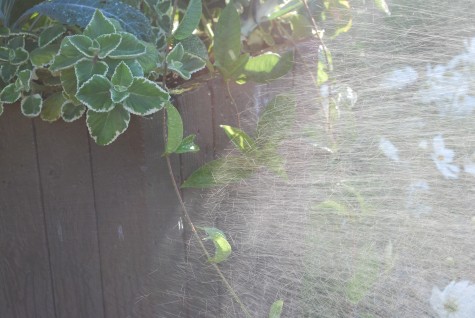 Taking 15 minutes a month to tune up your clock will save you countless hours and effort dragging a hose. Both Rob and Steve handwater everything-but their properties are small. I will say that though they have no automatic irrigation, both of their landscapes are happy and healthy. As I said, err on the side of too little.
Taking 15 minutes a month to tune up your clock will save you countless hours and effort dragging a hose. Both Rob and Steve handwater everything-but their properties are small. I will say that though they have no automatic irrigation, both of their landscapes are happy and healthy. As I said, err on the side of too little.
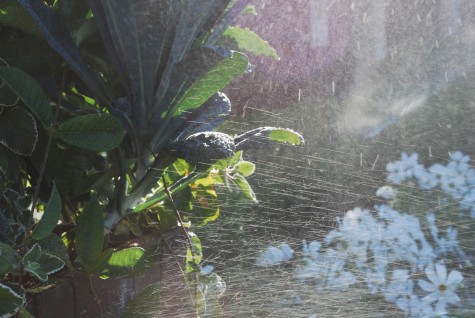 Automatic irrigation sends water into the air via a nozzle, or head, that is set to pop up once the irrigation goes on. Some nozzles that cover vast areas of lawn rotate as they spit out water. Smaller areas of shrubs or perennials may have nozzles called mist heads, that cover a much smaller area. Common to every nozzle is a flow rate. A good irrigation contractor will adjust the rate of flow of water after assessing all of your existing conditions. If you have zones that overlap, or zones in shade, you may want to reduce the flow. Less gallons per minute. But once your contractor has tuned up all of the mechanics to the best of his ability, thre responsibility for running that system will fall to the property owner.
Automatic irrigation sends water into the air via a nozzle, or head, that is set to pop up once the irrigation goes on. Some nozzles that cover vast areas of lawn rotate as they spit out water. Smaller areas of shrubs or perennials may have nozzles called mist heads, that cover a much smaller area. Common to every nozzle is a flow rate. A good irrigation contractor will adjust the rate of flow of water after assessing all of your existing conditions. If you have zones that overlap, or zones in shade, you may want to reduce the flow. Less gallons per minute. But once your contractor has tuned up all of the mechanics to the best of his ability, thre responsibility for running that system will fall to the property owner.
 Airborne water droplets evaporate quickly. You may use 100 gallons of water, of which only a percentage reaches the roots of the plants you are trying to water. For this reason, in ground irrigation is not designed to water new plants. Hand watering, that puts the water to the crown and roots is a necessity. A dusting of water over top a plant that has not yet sent out roots into the surrounding soil is not enough. New plantings need to be watched-and have your hand put to them. A babysitter will not do.
Airborne water droplets evaporate quickly. You may use 100 gallons of water, of which only a percentage reaches the roots of the plants you are trying to water. For this reason, in ground irrigation is not designed to water new plants. Hand watering, that puts the water to the crown and roots is a necessity. A dusting of water over top a plant that has not yet sent out roots into the surrounding soil is not enough. New plantings need to be watched-and have your hand put to them. A babysitter will not do.
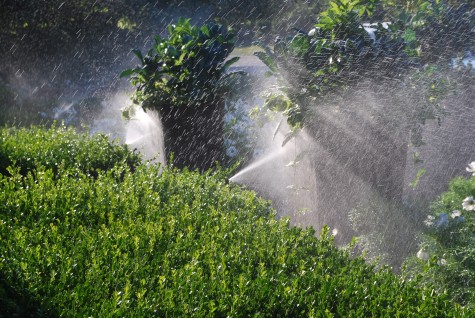 I will be the first to say that irrigation clocks were designed by some engineering type whose thought process is pretty much alien to my own. My clock is far too complex-just like my Suburban. I need forward, neutral, park, stop and go-I have 58 separate positions possible for the driver’s seat. This is vastly more than what I really need. I still have to call my irrigation person with questions about the clock. For certain, the one thing I have done that I find invaluable-a map of all the zones, and what they cover, pasted up next to the clock. I am only now learning how to change the duration of time on any zone given the percentage feature. When it is extremely hot-over 85 degrees, I up all the times on all the zones 140% to 200%. Ordinary summer hot, 85 degrees or less, I may water at 100%-130% of my normal time.
I will be the first to say that irrigation clocks were designed by some engineering type whose thought process is pretty much alien to my own. My clock is far too complex-just like my Suburban. I need forward, neutral, park, stop and go-I have 58 separate positions possible for the driver’s seat. This is vastly more than what I really need. I still have to call my irrigation person with questions about the clock. For certain, the one thing I have done that I find invaluable-a map of all the zones, and what they cover, pasted up next to the clock. I am only now learning how to change the duration of time on any zone given the percentage feature. When it is extremely hot-over 85 degrees, I up all the times on all the zones 140% to 200%. Ordinary summer hot, 85 degrees or less, I may water at 100%-130% of my normal time.
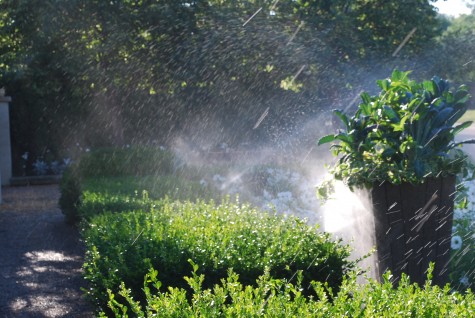
As I said first up, every bit of this came directly from, or is paraphrased from from Jack Linderman, who owns The Living Painting. Should you need some thoughtful help from an excellent irrigation contractor, I can recommend him. www.thelivingpainting.com.
The Last Little Bit
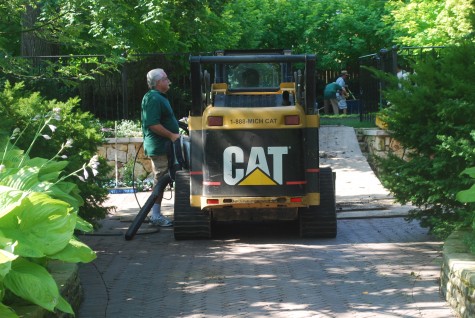 My entire landscape budget and a lot more for 2010 went to repairing the fountain of my dreams. So fine. But every gardener knows how one improvement project can lead to another. Buck made new steel edger strip for me, so the herniaria surrounding it would be on the same plane as the stone pool coping. All of the herniaria had to be replaced, so why not fix that grade while I had the chance? Given the heavy spring rains, it became apparent that the pool yard did not drain. The grass was drowning-especially in the shadier end of the garden. So why not fix the lot of the problems, and then move on to some place else in the garden? GP Enterprises came with a loader, a sod cutter, a plenty of plastic pipe. Their primary business is in the sale and moving of very large scale plant material, but they do drainage. Ralph would regrade the yard, install drainage pipe in gravel, and drain the water away in a solid pvc pipe to the driveway level garden. Sounds like fun, yes?
My entire landscape budget and a lot more for 2010 went to repairing the fountain of my dreams. So fine. But every gardener knows how one improvement project can lead to another. Buck made new steel edger strip for me, so the herniaria surrounding it would be on the same plane as the stone pool coping. All of the herniaria had to be replaced, so why not fix that grade while I had the chance? Given the heavy spring rains, it became apparent that the pool yard did not drain. The grass was drowning-especially in the shadier end of the garden. So why not fix the lot of the problems, and then move on to some place else in the garden? GP Enterprises came with a loader, a sod cutter, a plenty of plastic pipe. Their primary business is in the sale and moving of very large scale plant material, but they do drainage. Ralph would regrade the yard, install drainage pipe in gravel, and drain the water away in a solid pvc pipe to the driveway level garden. Sounds like fun, yes?
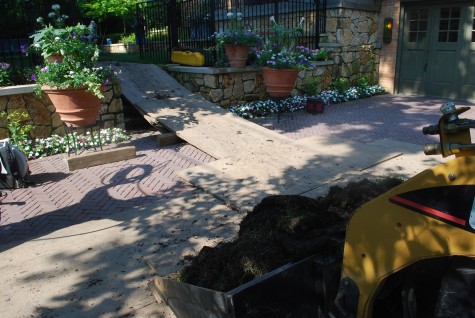 I know this sounds about as interesting as a trip to the dentist, but I knew it was time to address the problem. The entire yard was torn up anyway-what harm could a little more commotion do? The grass that came out of that yard had that too wet and rotting smell to it; I had made a good decision. The best part of the story-the water in the pool yard was going to empty into my bed of butterburrs. Butterburrs thrive on water; they are happy in decidedly swampy conditions.
I know this sounds about as interesting as a trip to the dentist, but I knew it was time to address the problem. The entire yard was torn up anyway-what harm could a little more commotion do? The grass that came out of that yard had that too wet and rotting smell to it; I had made a good decision. The best part of the story-the water in the pool yard was going to empty into my bed of butterburrs. Butterburrs thrive on water; they are happy in decidedly swampy conditions.
I went back to work after the first few yards of sod were stripped off. I am only a fan of watching the deconstruction phase of landscape in someone else’s yard-not my own. Too much water is frequently a problem in landscapes where the irrigation systems run amok. But some ground just does not drain fast enough to keep plants healthy. Too much water has the potential to rot the root hairs of every living plant. The irony here-no matter how much water you pour to a plant with root rot, there is no absorption going on.
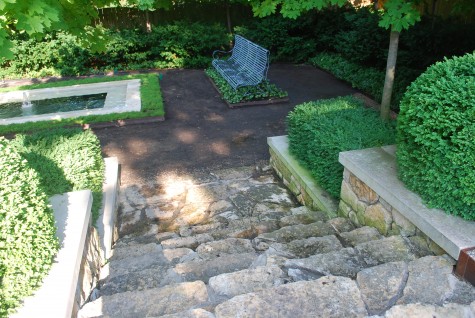 Of course the Corgis thought the dirt was great fun. They ripped around, rolled in it, tracked it onto the pool coping, and into the house. Fortunately this phase was only to last 24 hours.
Of course the Corgis thought the dirt was great fun. They ripped around, rolled in it, tracked it onto the pool coping, and into the house. Fortunately this phase was only to last 24 hours.
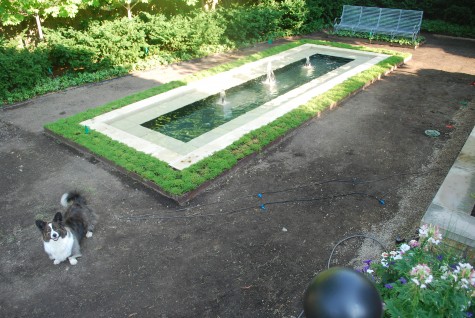
A perforated drain set in pea gravel was placed at the base of the wall. The nicked irrigation lines and low voltage lighting lines got repaired. I was handwatering my new herniaria, in addition to all of my pots. Having this to deal with in the 95 plus degree heat working outside all day long was exactly like a visit to the dentist. Not visible in this picture-I finally ripped out all the not hardy helleborus angustifolius, and replanted the remaining ferns with European ginger. I am happy about this change.
The drain pipe in place, all that remained outstanding was a finish grade, subtly sloping towards the drive, and the grass. Positive drainage-as in ground pitched such that water would naturally drain to a good spot, is the drainage method of choice. Pipes can get clogged, or are too small to handle a deluge of water. But where there is little pitch, a well done drainage system can be the difference between a landscape that thrives, and a swamp.
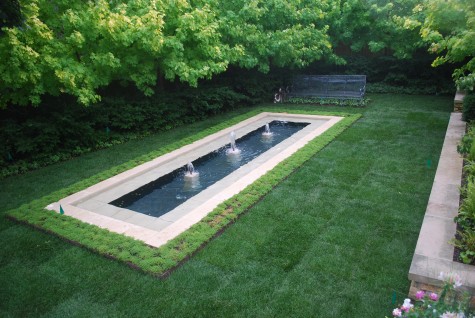
I do like my grass; it will take a while for this sod to root sufficiently such that it can be mowed. That green is the best, is it not?
Lady Miss Deadly, Datura Metel
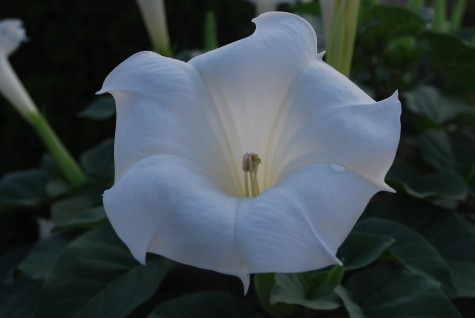 Datura metel is classified as an herb growing to three feet tall. This description does not begin to describe the plant. The upfacing flowers are incredibly beautiful; they open late, and fade early in the heat of the following day. Lots of flowers have this habit-morning glories, moonflowers and daylilies are but a few. None of the aforementioned have the size, substance or presence of datura metel, but they are easy to care for. Cultivating datura metel is not for the faint of heart. Should you handle this plant-wash your hands.
Datura metel is classified as an herb growing to three feet tall. This description does not begin to describe the plant. The upfacing flowers are incredibly beautiful; they open late, and fade early in the heat of the following day. Lots of flowers have this habit-morning glories, moonflowers and daylilies are but a few. None of the aforementioned have the size, substance or presence of datura metel, but they are easy to care for. Cultivating datura metel is not for the faint of heart. Should you handle this plant-wash your hands.
 Their felted leaves are large; the plants love the heat. A summer planting asking for considerable scale and enormous impact-datura comes to mind. Though there is a hybrid known as Belle Blanche, I favor the species. It grows vigorously, and sometimes survives my Michigan weather.
Their felted leaves are large; the plants love the heat. A summer planting asking for considerable scale and enormous impact-datura comes to mind. Though there is a hybrid known as Belle Blanche, I favor the species. It grows vigorously, and sometimes survives my Michigan weather.

The giant and elongated buds-I would think a photographic essay about datura would certainly merit a book. The flowers interest me, no matter the stage. I would not describe any annual flowers in terms of their drama-save datura. The Sarah Bernstein of annual plants-datura could be best described as pure beauty. This pure beauty comes with a price tag.
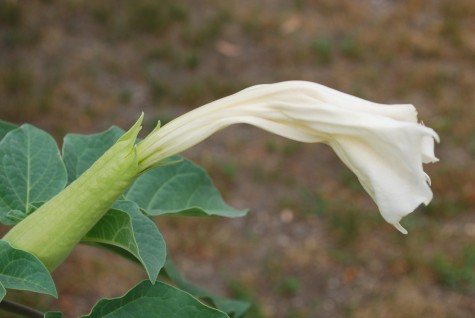
How eloquent, this faded blossom. Deadheading datura-dangerous. Every part of the plant is highly toxic. Infused with the poisonous tropane alkyloid; if you grow datura, you are aware you need to wash thoroughly after handling this plant. Taking off a leaf results in a foul and scary smell that says all. Danger Miss Deadly-that would be datura.
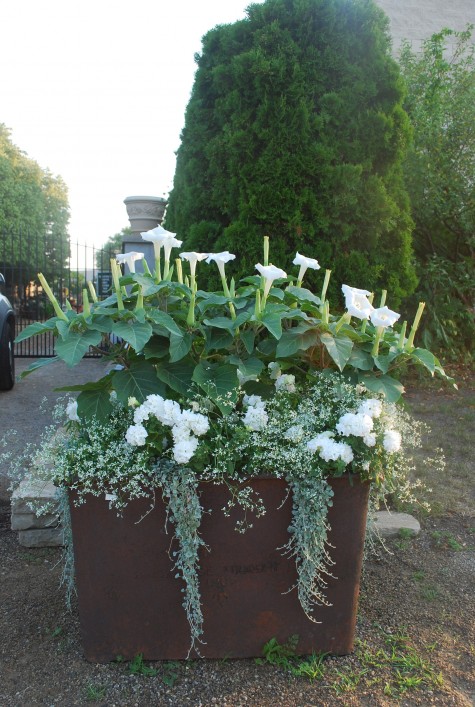 The danger does not deter me from growing datura. I am able to keep my hands out of my mouth after handling them, and keep every dead bloom off the ground. The foul smell of the leaves speaking of danger is more than offset by the delicious perfume of the flowers. This old English iron cistern we placed at the road; the daturas say hello and welcome. The sun at 7am will soon influence the blooms to close, and drop. By 9am, the late afternoon early morning display is finished.
The danger does not deter me from growing datura. I am able to keep my hands out of my mouth after handling them, and keep every dead bloom off the ground. The foul smell of the leaves speaking of danger is more than offset by the delicious perfume of the flowers. This old English iron cistern we placed at the road; the daturas say hello and welcome. The sun at 7am will soon influence the blooms to close, and drop. By 9am, the late afternoon early morning display is finished.
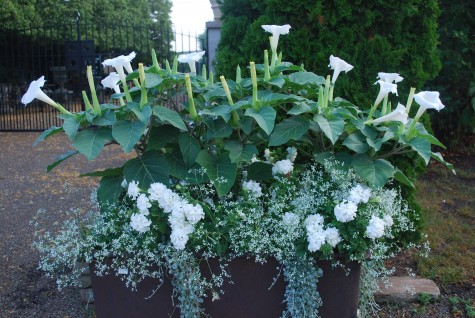 I took this photograph of the cistern at 5:45 am. In full sun, the daturas handle the light and the heat. The foliage is medium green; the leaves hairy. Very early on, they look engagingly bluish. Does not your garden read so differently, given the time of day? I so like plants that respond to light; datura, entirely light reactive.
I took this photograph of the cistern at 5:45 am. In full sun, the daturas handle the light and the heat. The foliage is medium green; the leaves hairy. Very early on, they look engagingly bluish. Does not your garden read so differently, given the time of day? I so like plants that respond to light; datura, entirely light reactive.
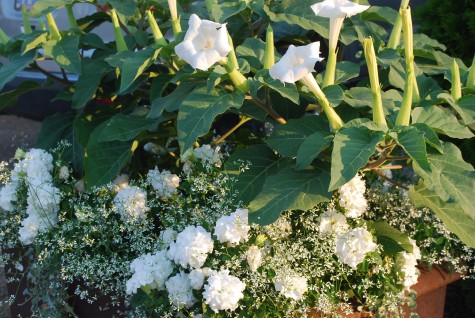 A sunny morning-they are not deterred. Rob moved this cistern to the road, and planted these datura. Every day, this chunk of a cistern pot loaded with datura, double petunias and euphorbia says hi when I pull up. I would be hard pressed to ignore this. A big and bold herb that can deal with heat-my kind of plant.
A sunny morning-they are not deterred. Rob moved this cistern to the road, and planted these datura. Every day, this chunk of a cistern pot loaded with datura, double petunias and euphorbia says hi when I pull up. I would be hard pressed to ignore this. A big and bold herb that can deal with heat-my kind of plant.
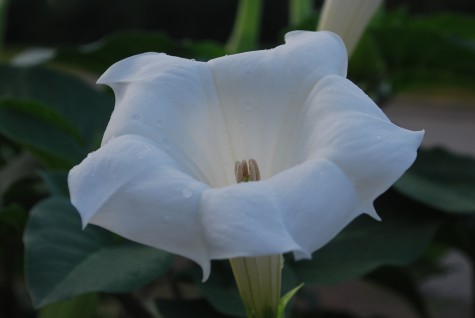
The flowers-incredible. Really incredible. A datura shrub in full bloom-who would not take time to marvel about the miracle that is nature?

